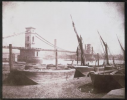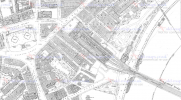Rummaging through my collection of railway-theme pages from the Illustrated London News, I've come across page 161 for 13 Feb. 1864, which has an account of the station as it opened, with 3 engravings, the temporary entrance to the station from Villiers Street, the covered way leading to the platforms and the signal station on the north end of the bridge (the latter has been reproduced in several books). It gives an idea of the work involved in the contract for the line from London Bridge: 2 miles of line, 17 bridges, 190 brick arches, a 404 foot long iron viaduct at Borough Market, and the station itself, the roof weighing 1200 tons, while the bridge involved 5000 tons of wrought iron and 2000 tons of cast iron. It goes on to say "at present trains run ... every quarter of an hour [from] 7.10 a.m. up to 25 past 12 at night;and there are 140 journeys made daily to and from Greenwich, and 34 on the Mid-Kent line. On the 1st of March the line ... will be open for North Kent traffic; and upon the 1st of May will be in working order ... for South Eastern and Continental business". These trains "will be supplemented in a year or so by another series, in itself requiring an every five-minute traffic ... that to Cannon Street, for which at present there is only a single line of rails provided."
The station was built on the site of the old Hungerford Market, described as "the west end Billingsgate". There was a Hungerford Music Hall too.
Another page, p. 317, for 31 March 1860, is a full page illustration of the proposed bridge before it was built (too big to scan unfortunately, as the ILN pages were nearly A3 in size).
On page 162 for 13.2 64 , there is a paragraph about railway schemes in the City of London; there were no less than 23 proposals for lines affecting the City, almost a second Mania. I wonder what the North and South London High Level Junction, for example, was?
All this area has nostalgic memories of the 1970s for me, when I used to meet a friend frequently in the Archduke wine bar, in one of the arches under the south approach to Hungerford Bridge, near the Royal Festival Hall.


